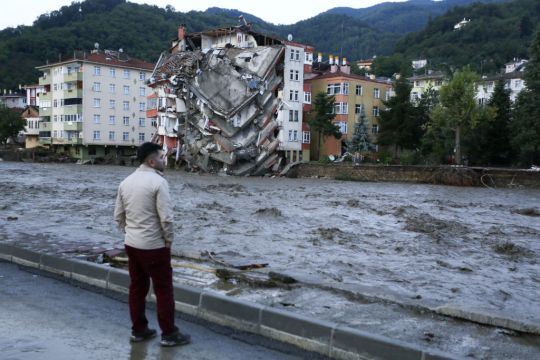The death toll from severe floods and mudslides that struck northern Turkey has reached at least 31.
The floods battered the Black Sea coastal provinces of Bartin, Kastamonu, Sinop and Samsun on Wednesday, demolishing homes and bridges and sweeping away cars.
Hundreds of people were rescued by helicopters, while 1,700 others were evacuated. More than 300 more people are said to be missing.

The Disaster and Emergency Management Presidency (AFAD) said rescuers recovered 10 more bodies in the worst-hit area, Kastamonu, bringing the fatality toll to 27.
An 80-year-old woman is still missing in Bartin province.
Floodwaters inundated much of the town of Bozkurt, in Kastamonu, where one building collapsed and a second building was severely damaged.
In Bartin province, at least 13 people were injured when a section of a bridge caved in.
Five bridges collapsed in the floods while two others were damaged, AFAD said. Hundreds of villages were left without power and several roads were blocked.

Speaking in Bozkurt late on Thursday, interior minister Suleyman Soylu described the scenes as “the most severe flood disaster I have seen”.
President Recep Tayyip Erdogan, who cancelled celebrations marking his ruling party’s 20th anniversary, visited the area on Friday and promised to reconstruct demolished homes, roads and bridges.
“With God’s permission, we will overcome this disaster as well. We will do whatever it takes as a state… and hopefully, we will rise from our ashes,” Erdogan said.
Turkey’s Black Sea region is frequently struck by severe rains and flash flooding. At least six people were killed in floods in the eastern Black Sea coastal province of Rize last month.
The disaster struck as firefighters in south-west Turkey worked to extinguish a wildfire in Mugla province, an area popular with tourists that runs along the Aegean Sea.

The blaze, which was brought under control on Thursday, was one of more than 200 wildfires in Turkey since July 28.
At least eight people died and thousands of residents have had to flee fierce blazes.
Climate scientists say there is little doubt that climate change from the burning of coal, oil and natural gas is driving more extreme events, such as heatwaves, droughts, wildfires, floods and storms.
Such calamities are expected to happen more frequently as the planet warms.







